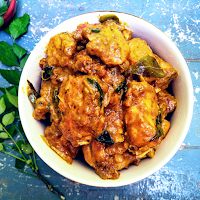Chicken 65 is one of the popular dishes of South Indian cuisine. Chicken 65 is a spicy, deep fried tasty chicken delicacy, originated in Chennai, India. It was first introduced in 1965 by the Buhari Hotel Restaurant in Chennai.
Boneless pieces of chicken are marinated with different spices, flour and curry leaves and thereafter deep fried in oil. Chicken 65 can be served as dry or as gravy. For gravy, the flour coated chicken pieces are again sauteed into a spicy curd gravy.
Although the chicken 65 is a boneless chicken dish, I also use pieces of chicken with bones because my kids like it that way.
The recipe is not that complicated and I have used simple home ingredients which I store in my kitchen. Serve chicken 65 as a starter or as a side dish.
Chicken 65 Gravy Recipe
📎Course : Side Dish
📎Cuisine : South Indian
🔪Preparation Time : 30 minutes
♨Cooking Time : 30 minutes
🕞Total : 60 minutes
🍴Servings : 2-3
INGREDIENTS:
For Marination :
For Marination :
- 500 gms of chicken (boneless)
- 1 tbsp ginger garlic paste
- 1/2 tsp turmeric powder
- 1/2 tsp cumin powder
- 1/2 tsp coriander powder
- 1/2 tsp red chilli powder
- 1/2 tsp garam masala powder
- 2 tbsp all purpose flour (maida)
- 1/2 tbsp corn flour
- 1 beaten egg
- 1/2 tsp vinegar (optional)
- 10-12 curry leaves
- salt taste
For frying :
- Oil as required to fry
For gravy :
- 1/3 cup hung curd
- 1 small piece of finely chopped ginger
- 3-4 finely chopped garlic cloves
- 8-10 curry leaves
- 2 chopped green chillies
- 1/2 tsp red chilli powder
- 1/2 tsp garam masala powder
- 2- 3 drops of orange food colour
- 2 tbsp of oil
- Salt to taste
METHOD:
For marination:
- Wash chicken pieces under running water.
- In a bowl take chicken pieces. Add ginger garlic paste, turmeric powder, cumin powder, coriander powder, garam masala or, red chilli powder, curry leaves and salt. Mix well.
- Add beaten egg, all purpose flour (maida), corn flour and vinegar. Mix everything well.
- Rest the marinade in refrigerator for half an hour.
For gravy :
- Heat oil in a pan.
- Take out the marinade from the refrigerator. Deep fry the chicken pieces until turns golden brown. Drain and keep aside.
For frying :
- In a pan heat oil.
- Add finely chopped ginger and garlic. Saute for few seconds.
- Add chopped green chillies and curry leaves and saute.
- Add beaten curd.
- Add salt, red chilli powder, garam masala powder and food colour. Mix everything well.
- Now add fried chicken pieces and cook for 5-10 minutes by stirring constantly.
- Now your chicken 65 is ready to serve.
- Serve hot.


Comments
Post a Comment